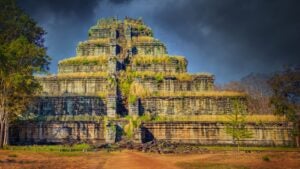There’s a New World Heritage Site in the U.S.
More than 60 new World Heritage sites were just announced by Unesco, and one of them is a collection of incredible Native earthworks made nearly 2,000 years ago
New perk: Easily find new routes and hidden gems, upcoming running events, and more near you. Your weekly Local Running Newsletter has everything you need to lace up! .
On Tuesday, September 19, a series of meadows containing Native earthworks in Ohio was granted the same status held by world-famous locales such as Easter Island, the Great Wall of China, and the Notre Dame Cathedral. Last week, the 45th meeting of the Unesco World Heritage Committee heard proposals for over 70 potential new , locations with “cultural and natural heritage around the world considered to be of outstanding value to humanity.”
The , a National Historic Park, isn’t as immediately striking as someplace like the Taj Mahal. It’s a collection of remains of giant geometric shapes made with rocks by Indigenous Hopewell people nearly 2,000 years ago. Slate reporter Dan Kois described some of the Hopewell sites as literally difficult to see, since they had been worn down and disturbed in parts by time and human activity—several have been plowed over by farmers who worked the land before the park was formed in 1923. “The prehistoric walls were both too subtle and too grand for my eye to comprehend,” .��

The National Park Service uses “interpretive mowing” to highlight the remaining rock shapes, leaving the plants growing on the forms taller than the surrounding grass. The stone walls used to stretch over 12 feet tall, but now lay close to the ground. Some, like the 800,000 square-foot circle and square at the Hopeton Earthworks site, were built to track the movements of the sun and moon, and all the remaining earthworks have spiritual, ceremonial significance.
The National Park Service describes artifacts found at the earthworks as “among the most outstanding art objects produced in pre-Columbian North America,” and says that there’s evidence those who built the earthworks “interacted with people as far away as the Yellowstone basin and Florida.” The structures were nominated for being “Masterpieces of Human Creative Genius” and “a unique testimony to the tradition of the Indigenous Hopewell culture two millennia ago.”

Tribal leaders from the Seneca Nation, the Miami Nation, the Pokagon Band of Potawatomi, the Wyandotte Nation, and the Eastern Shawnee Tribe, who can trace their own lineage to the Hopewell, were present when the Unesco committee passed the resolution to add the Earthworks to the esteemed list of World Heritage sites.��
“My immediate reaction is to shout and shout with joy,” Genna Wallace, chief of the Eastern Shawnee Tribe, when the verdict was announced. “But at the same time, my eyes are moist with tears, and my lips, my chin, and my voice tremble.”
“They were not just geniuses,” she said of the ancestors who built the Hopewell earthworks. “They were uncommon geniuses.”

The U.S.’s newest spot of “outstanding value to humanity” isn’t hard to get to—just a 45-minute drive from downtown Columbus, Ohio. The earthworks are also only ten miles from I-70, making them an easy stop for anyone road tripping through the area.��
Unesco designated as World Heritage Sites at last week’s meeting. The destinations include caves in Italy, fortresses from the Viking era in Denmark, Bronze Age monuments in Mongolia, and a cathedral in Ukraine, among a number of other historic, cultural, and naturally beautiful places.


